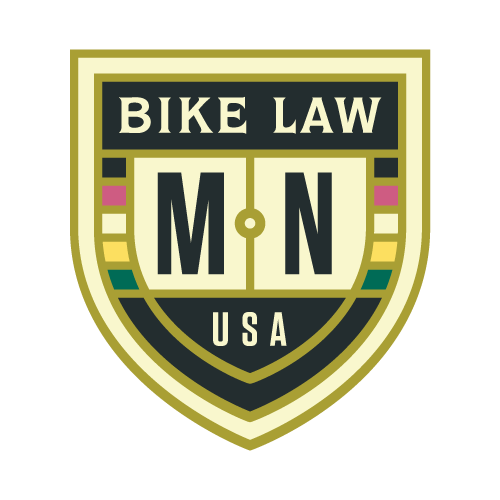It’s important to know your legal rights (and duties) when bicycling in Minnesota. It is especially important after a bicycle accident (we call them bicycle “crashes” and explain why here).
This is a general overview of Minnesota’s bicycle laws. To see them in their completion, please visit Minnesota’s Department of Transportation. For any questions about this State’s bike laws, or about your rights to the road, contact Minnesota’s Bike Law Attorney Dan Brazil directly.
Right to the Road
Bicycles are defined as vehicles and generally have the same rights and responsibilities as motor vehicle drivers.
Where to Ride
- Bicyclists are required to ride as close as practicable to the right-hand curb or edge of the roadway, when riding slower than the speed of traffic.
- Full lane use is allowed when traveling at the normal speed of traffic, preparing for a turn, overtaking and passing, avoiding hazards or unsafe conditions, traveling in a lane too narrow to share, and avoiding a mandatory turn lane.
- Bicyclists may, but are not required to, utilize any usable path for bicycles that has been provided adjacent to a roadway.
- Except within the business district, bicycles are permitted on sidewalks when bicyclists yield to the right-of-way of any pedestrian and give an audible signal when overtaking and passing any pedestrian. Check local ordinances for variations on this rule.
HOW TO RIDE
- Bicyclists must not ride more than two abreast and shall not impede the normal and reasonable flow of traffic.
- Bicyclists are required to slow down and come to a complete stop at stop signs and traffic devices signaling red.
- Bicyclists must signal when turning or coming to a stop.
Bicyclists Overtaking Cars
Bicyclists on roadways must exercise due care and leave a safe distance when passing a standing vehicle or one proceeding in the same direction.
Cars Overtaking Bicyclists
Motor vehicle drivers are required to pass bicyclists at a safe distance of no less than three (3) feet clearance.
Equipment
- At night, a bicycle must be equipped with a front white light visible from 500 feet away and a rear red reflector visible from 100 to 600 feet away.
- Every bicycle must have a rear brake or front and rear brakes which enable the bicyclist to make the braked wheels skid on dry, level, clean pavement. A bicycle equipped with a direct or fixed gear that can make the rear wheel skid on dry, level, clean pavement is compliant.
Prohibitions
- Bicyclists are required to ride within one lane, no lane splitting.
- Bicyclists may not carry any package that prevents him/her from keeping both hands upon the handlebars or impedes the proper ability to brake.
- Clinging to motor vehicles while bicycling is not permitted.
- A bicycle may not carry more than the number of persons for which it is designed.
- Bicyclists may not park on sidewalks.
Minnesota No-Fault Law and Bicyclists
- In Minnesota, if a bicyclist has a vehicle covered by auto insurance and is injured on their bicycle, their own automobile insurance provides No-Fault coverage (in most situations and cases).
- No-Fault coverage means a minimum of $20,000 of medical coverage, and $20,000 of wage loss coverage, as well as other benefits.
- The fact that there is No-Fault coverage does not mean a bicyclist has no claim against a driver at fault in the accident. Instead, the bicyclist typically has both a No-Fault claim and a bodily injury claim against the driver at fault.
- This is a benefit to the bicyclist since No-Fault payments for bills and wage loss are usually made quite promptly.
Accidents Due to Defective Bicycle
- When a bicycle defect causes a crash and injury, a claim can be made for the defect in Minnesota.
- Minnesota law is extremely complicated in cases of defective bicycles, and a full explanation is not possible, as it would be very lengthy.
- It is important to keep in mind that in defect cases, it is critical that the defective bicycle and all defective parts be kept and not lost.
- The bicycle and parts must be kept in the same condition as on the day of the accident.
